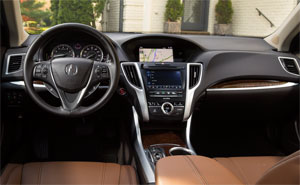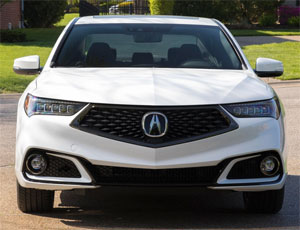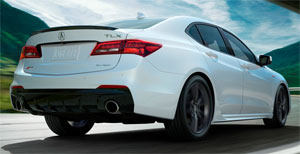2018 Acura TLX
Just 3 years ago, Acura pared down their sedan lineup by replacing both the TL and TSX with the single TLX. Reviews certainly weren’t bad, as its luxurious blend of technology and performance fit right in with flagship RLX. However, most would say it was not as exciting as it could be, and even Acura agreed with that. So let’s see if a revised 2018 TLX is the right answer.
Adding a new dose of excitement to the 2018 Acura TLX starts with an updated look. Front fascia, fenders, and hood are all new; and the Jewel Eye headlights are re-designed. But, best of all, Acura has replaced the awkward “shield-like” grille with the much more attractive “diamond pentagon” first seen on their Precision concept.
V6 models take it a smaller step further with freshened rear fascia and new exhaust tips.
All in all, it makes for a more dynamic take on what was already there.
 No radical changes to the inside either, other than updated software for the twin-screen infotainment system, which we were happy to see. We’re still not fans of the overall design, but it’s much more responsive than before. Android Auto and Apple CarPlay are now in play, but we found it odd that the apps show up in the upper screen which uses a central controller, not the lower touchscreen.
No radical changes to the inside either, other than updated software for the twin-screen infotainment system, which we were happy to see. We’re still not fans of the overall design, but it’s much more responsive than before. Android Auto and Apple CarPlay are now in play, but we found it odd that the apps show up in the upper screen which uses a central controller, not the lower touchscreen.
A carryover 206-horsepower 2.4-liter I4 engine is still standard; with an 8-speed dual-clutch transmission.
Upgrade to the 3.5-liter V6; and in addition to 290-horsepower, 267 lb-ft. of torque, and a revised 9-speed automatic transmission, you can get mechanical Super Handling all-wheel-drive. Those without all-wheel-drive come with Acura’s rear-toe adjusting Precision All-Wheel Steer.
Our early drive time came in the rolling hills around Louisville, Kentucky; the majority spent with the V6. The 9-speed transmission is very smooth, and with both drive systems, ride quality is equally compliant.
Putting the Integrated Dynamics System in Sport+ increases steering feel and throttle response, adds some engine noise, initiates more aggressive programming for the transmission and SH-AWD, and even cuts the HVAC system out temporarily when at full throttle.
 It certainly wakes things up a bit, but not to full-alert status. So, where’s the real excitement coming from?
It certainly wakes things up a bit, but not to full-alert status. So, where’s the real excitement coming from?
Well, that’s what the new TLX A-Spec is for. Available with V6 only, the A-Spec gets retuned electric power steering; and when combined with SH-AWD, adds stiffer springs as well as a rear stabilizer bar that keeps things much flatter and confidence inspiring in corners.
SH-AWD worked as great as always, torque vectoring us around corners even in the rain. And while we still don’t think the best handlers in the luxury sport sedan category have anything to worry about, the TLX has certainly moved up the list, and more importantly without losing any of Acura’s luxury feel.
And speaking of feel, we love the thicker steering wheel that comes with the A-Spec. Other interior highlights are more heavily-bolstered seats, red trim for the gauges, and brushed aluminum trim.
A-Spec exteriors are also set apart with their own unique blacked-out front fascia, round fog lamps, pronounced sill extensions, 19-inch wheels with high performance Michelin Primacy tires, rear diffuser with round exhaust outlets, as well as gloss black rear spoiler and trim.
 A host of AcuraWatch safety systems are available, but Collision Mitigation Braking is standard on all models.
A host of AcuraWatch safety systems are available, but Collision Mitigation Braking is standard on all models.
Government Fuel Economy Ratings range from the 2.4-liter’s 23-City, 33-Highway, and 27-Combined; to the 3.5-liter SH-AWD A-Spec’s 20-City, 29-Highway, and 23-Combined.
Some shuffling of prices and more standard features, results in a slight increase in base price, now at $33,950. Stepping up to all-wheel-drive or A-Spec will have you around $40,000, though you no longer have to opt for Technology or Advance packages to get SH-AWD.
They say competition brings out the best in people, and surely that sentiment applies to the automotive world. The 2018 Acura TLX is certainly the best it’s ever been, but also still unique in that it’s not trying to be a BMW; rather a whole lot more exciting TLX. And that’s good news to Acura fans, and us!
Specifications
- Engine: 3.5 liter
- Horsepower: 290
- Torque: 267 lb-ft.
- EPA: 20 mpg city / 29 mpg highway
2025 Volkswagen ID. Buzz
Volkswagen Brings Beetlemania Level Of Excitement To Minivan Segment
The duty of upholding Volkswagen’s heritage has most recently been delegated to small legacy car names like Golf and Jetta. But hold on! A much larger, totally modern take on VW’s classic microbus has just buzzed over the horizon— the all-electric ID. Buzz. It’s been at the top of our minds since we first saw the concept back in 2017. Well, it’s finally here, so let’s get our groove into drive!
This 2025 Volkswagen ID. Buzz has indeed created the most buzz around Volkswagen since the Beetle’s return to the U.S. in the late 1990s. We couldn’t drive it anywhere without drawing a crowd. No wonder, just about everyone has a VW Microbus story to tell, and seeing this reimagined version rolling down the street brings back all those memories.
VW really pulled it off as far as we’re concerned, as it looks great without appearing over the top. All the cues are here: Big VW logo front and center, lots of greenhouse including A-pillar windows and mini sliders for the second-row passengers, D-pillar air vents, and two-tone wheels. And while its appearance may be pure retro, its drivetrain is far from it, as the ID. Buzz is all-electric, and unlike the new Beetle, the Buzz does retain the original Microbus’ rear-drive architecture.
Powering those rear wheels is a 210-kW motor drawing juice from a 91-kWh battery for a range of 234 miles; 200-kW max charging will get you to 80% in about 26 minutes. Buyers can add another small 80-kW motor up front for 4motion all-wheel-drive and an increase of total output from 282 to 335 horsepower with a combined 512 lb-ft of torque. It uses the same battery, but range estimates drop just slightly to 231 miles. But while those numbers are modest, we also found them to be quite conservative, as we observed as many as 287 miles available in our all-wheel-drive tester’s gauge display and were on pace for 273 miles in our driving loop.
One throwback theme that may be a turnoff to some is that it’s quite a step up into the Buzz’s front seats, but there’s certainly a commanding view of the road once you climb in. Second row seating can be either a three-place bench or a pair of captain’s chairs, so there’s generous room for seven or six passengers. The captain’s chairs in our Pro S Plus offer good support and very easy access to the third row.
Lots of flexibility too with the option to simply fold the seats or remove them altogether.
With the sliding side doors and a wide opening rear hatch, there’s plenty of access for loading big sport utility amounts of cargo. Lots of flexibility too with the option to simply fold the seats or remove them altogether, and the ability to create a full-length flat floor with a rear cargo shelf that covers some handy removable storage bins. There’s 18.6 cubic-feet of space behind the third row, 75.5 behind the second, and a max of 145.5. That’s more than a Chevrolet Tahoe. For smaller items, there are lots of cubbies throughout the cabin, along with a standard Buzz Box that can be moved to multiple locations.
With a design that prioritizes retro form and modern function over aero efficiency, the 4motion equipped ID. Buzz earns a Fair efficiency rating, using 42-kWh of electricity per 100 miles, and we weren’t sure what to expect at our Mason Dixon test track.
What we found was great torque off the line and drama free launches to 60 in just 5.3 seconds. It was very stable at speed and power delivery stayed steady most of the way down the track until we reached about 90 mph, when it began to taper off just before we finished the quarter-mile in 14.0 seconds flat at 97 mph.
With 1,200-lbs. of battery weight nestled in its 127.5-inch wheelbase, the Buzz felt planted to the pavement through our handling course. There was quite a bit of body roll to deal with, but surprisingly little understeer. In panic braking runs, pedal response was inconsistent, feeling soft at times, pushing back hard at others; but through it all, results were quite good, stopping from 60 in an average of just 108 feet.
Three interior themes are available, this Dune is the brightest, featuring coastal inspired wood optic dash décor, “gray and clay” leatherette surfaces, and a high-mounted central 12.9-inch touchscreen. Pricing starts with a rear-wheel-drive Pro S at $61,545; this Pro S Plus begins at $65,045, add another $4,500 for 4motion, which brings a few extra features along with all-wheel drive.
Retro design with old-school VW charm, modern EV drivetrain, big SUV capacity merged with minivan flexibility; it all comes together in this 2025 Volkswagen ID. Buzz. It’s easily one of the coolest rides of the year and one that will likely keep Volkswagen dealers buzzing for years to come, and that’s something no other people and things mover can say.
Specifications
As Tested
- Motor Setup: Dual-Motor AWD
- Battery Size: 91-kWh
- Horsepower: 335
- Torque: 512 lb-ft
- EPA Range: 231 miles
- 0-60 mph: 5.3 seconds
- 1/4 Mile: 14.0 seconds at 97 mph
- Braking, 60-0: 108 feet
- MW Test Loop: ~ 273 miles













































